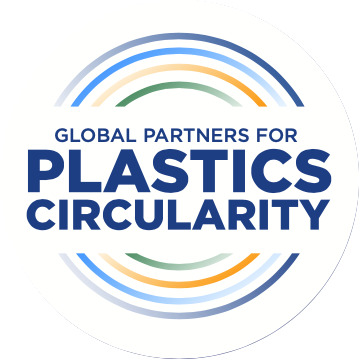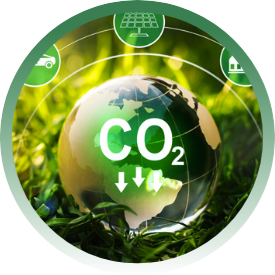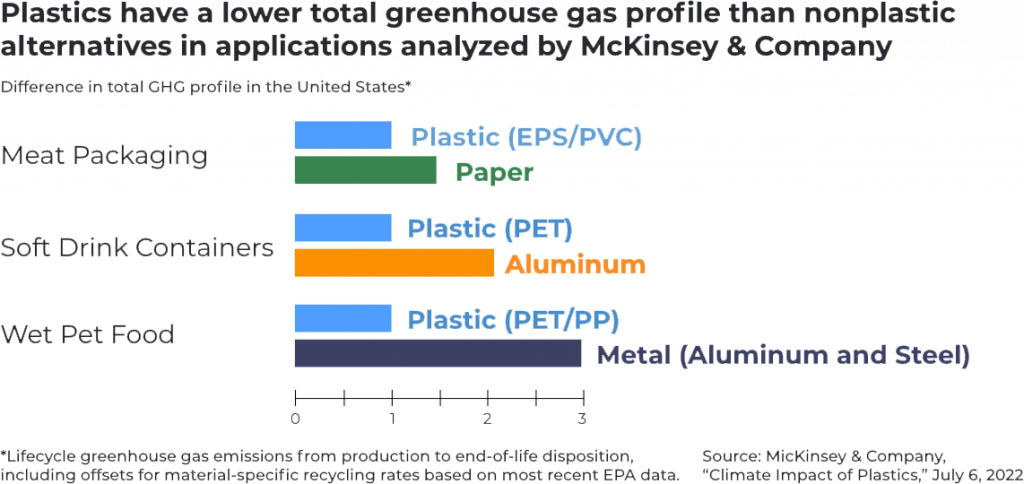
PLASTICS ARE ESSENTIAL TO MEETING SUSTAINABLE DEVELOPMENT GOALS
Lightweight and efficient plastic materials will play an essential role in helping achieve UN Sustainable Development Goals (SDGs). Plastics contribute directly to multiple SDGs, most notably goals on climate action, affordable/clean energy, water/sanitation, and zero hunger. As nations deliberate over a global agreement on plastic pollution, its critical to recognize the contributions of plastics to SDGs.


Sustainable Development Goals and Plastics
Plastics are lightweight and efficient materials that allow us to do more with less material, which contributes to sustainability and helps drive down greenhouse gas emissions.


Help Drive Down Greenhouse Gas Emissions
Life Cycle Analyses (also see below) typically find that use of plastics in consumer products
and packaging can significantly reduce greenhouse gas emissions compared to alternatives,
primarily because strong-yet-lightweight plastics require much less material to perform similar functions. This means that plastics can contribute to helping lower our carbon footprint and combatting climate change.

Increase Vehicle Fuel Efficiency
Carmakers use durable, lightweight plastics to decrease the weight of car parts, which reduces our fuel use and greenhouse gas emissions. In fact, today’s cars on average are made of about 50% plastics by volume but only 10% by weight. Light-weighting is also critical to increasing the battery range of low-carbon electric vehicles

Increase Home/Building Energy Efficiency
To drive down energy use and greenhouse gas emissions, energy-saving plastic building materials improve insulation performance (R-value) and limit unwanted airflow. Plastic building products – foam insulation, house wrap, window frames, and caulks/sealants – play a crucial role in sealing a building’s envelope against heating and air conditioning losses, which saves energy and reduces greenhouse gas emissions


Help Expand Wind Energy
To expand wind power as a low-carbon energy source, we need an expanded supply of strong-yet-lightweight wind turbine blades, mostly made from various lightweight plastic composites such as carbon fiber-reinforced plastic. Engineers continue to create lighter, more efficient blades to drive down greenhouse gas emissions further, most of which involve modern polymer composites/plastics.

Help Expand Solar Energy
Plastics play a growing role in improving efficiencies and cost effectiveness of solar energy, supplying essential films/sheets that help protect glass and silicon panels from the environment, plus electrical insulators, pipes, valves, and fittings. Advances in plastic solar cells could usher in more affordable, flexible, lightweight, and durable solar energy panels.

Improve EV Batteries
Specialty plastics help protect the battery pack and guard against fire hazards from EV batteries, contributing to safety. Plus, advanced plastic-based battery separators for lithium-ion batteries can boost battery power by up to 30%, enhance temperature stability and extend EV range under a single charge.


Upgrade Water Delivery/Infrastructure
Durable plastic pipes can upgrade aging water infrastructure, improve its resiliency, and cut energy use. Plastic pipes typically are more economical to install and maintain and often can retrofit crumbling and rusting pipes without digging massive trenches. They can also reduce energy needs by significantly reducing drag of moving water through old fashioned pipes.


Reduce Food Waste
According to FAQ, nearly 1/3 of the world’s food is lost or wasted every year. Plastic packaging keeps perishable foods such as meat and bread fresher longer, reducing spoilage and helping curb food waste. Plus, sanitary packaging can play a critical role in helping prevent foodborne illnesses.

Life Cycle Analyses – Essential Policy Making
Policymakers are increasingly relying on life cycle analyses (LCAs) that study the environmental impacts of consumer goods, from extraction of raw materials to final disposition. For example, UN Environment hosts The Life Cycle Initiative, a public-private, multi-stakeholder partnership enabling the global use of credible life cycle knowledge by private and public decision makers.
LCAs can lead to better decision making, often by comparing the multiple environmental impacts of materials and products. For example, based on decades of LCAs and similar analyses that study the environmental impacts of consumer goods, multiple researchers have concluded.

The use of plastic packaging and consumer products can significantly reduce greenhouse gas emissions compared to alternatives such as steel, paper, aluminum, glass, etc. (Trucost, 2016) (Denkstatt, 2020) (Plastics Europe Eco-profile set) (McKinsey, 2022)
Likewise, replacing plastics with alternatives in these applications would significantly increase greenhouse gas emissions.

Plastics in use today are helping combat climate change and are key to a lower carbon future.
These LCAs help recognize the role plastics play in reaching multiple SDGs and meeting climate contributions (Nationally Determined Contributions). LCAs must be considered when deliberating over a global agreement on plastic pollution.
Championing a global agreement for a sustainable, circular economy.
